 Technology peripherals
Technology peripherals
 AI
AI
 AIGC that conforms to the human creative process: a model that automatically generates growth stories emerges
AIGC that conforms to the human creative process: a model that automatically generates growth stories emerges
AIGC that conforms to the human creative process: a model that automatically generates growth stories emerges
In today’s field of artificial intelligence, AI writing artifacts are emerging one after another, and technology and products are changing with each passing day.
If the GPT-3 released by OpenAI two years ago is still a little lacking in writing, then the generated results of ChatGPT some time ago can be regarded as "gorgeous writing, full plot, and logical logic" It’s both harmonious and harmonious.”
Some people say that if AI starts to write, it will really have nothing to do with humans.
But whether it is humans or AI, once the "word count requirement" is increased, the article will become more difficult to "control".
Recently, Chinese AI research scientist Tian Yuandong and several other researchers recently released a new language model-Re^3. This research was also selected for EMNLP 2022.

Paper link: https://arxiv.org/pdf/2210.06774.pdf
Tian Yuandong once introduced this model on Zhihu:
The idea of Re^3 is extremely simple. By designing prompts, it can generate strong consistency story, no need to fine-tune the large model at all. We jump out of the linear logic of word-by-word generation of the language model and use a hierarchical generation method: first generate the story characters, various attributes and outlines of the characters in the Plan stage, and then give the story outline and roles in the Draft stage, and repeatedly generate specific Paragraphs, these specific paragraphs are filtered by the Rewrite stage to select generated paragraphs that are highly related to the previous paragraph, while discarding those that are not closely related (this requires training a small model), and finally correct some obvious factual errors in the Edit stage.
Method Introduction
The idea of Re^3 is to generate longer stories through recursive Reprompt and adjustments, which is more in line with the creative process of human writers. Re^3 breaks down the human writing process into 4 modules: planning, drafting, rewriting, and editing.
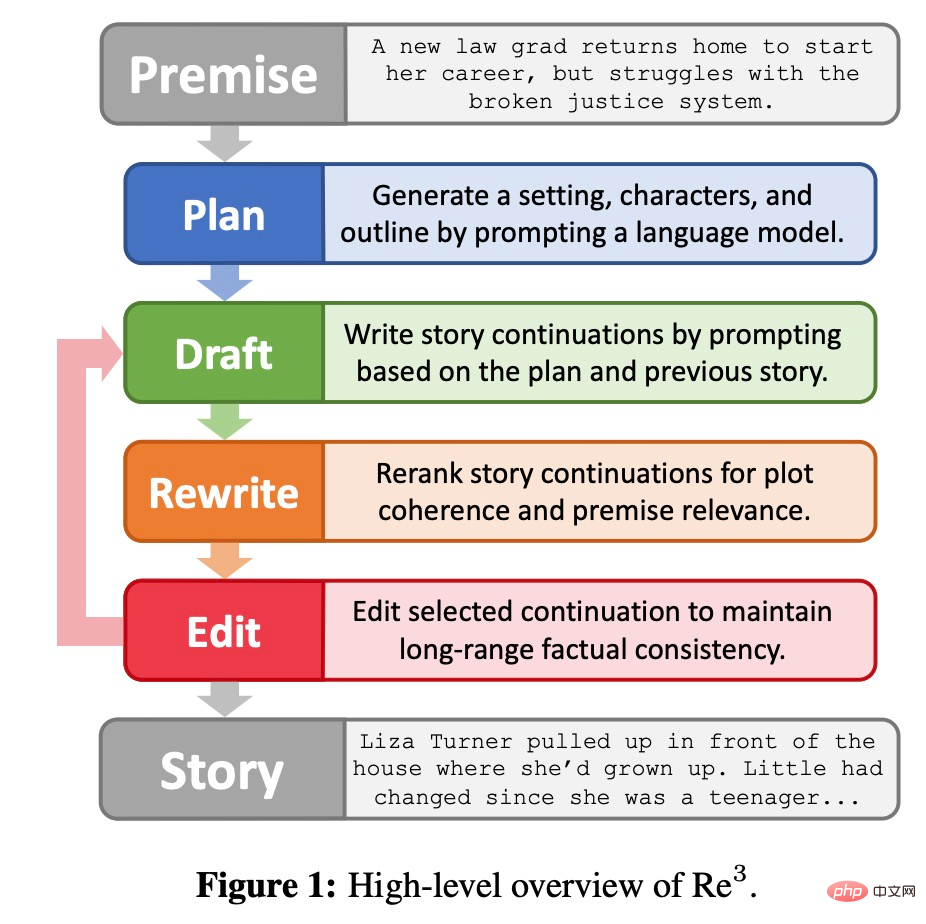
Plan module
As shown in Figure 2 below , the planning module will expand the story premise (Premise) into background, characters and story outline. First, the background is a simple one-sentence extension of the story premise, obtained using GPT3-Instruct-175B (Ouyang et al., 2022); then, GPT3-Instruct175B regenerates character names and generates character descriptions based on the premise and background; finally, the Method prompt GPT3-Instruct175B to write the story outline. The components in the planning module are generated by prompt themselves and will be used over and over again.
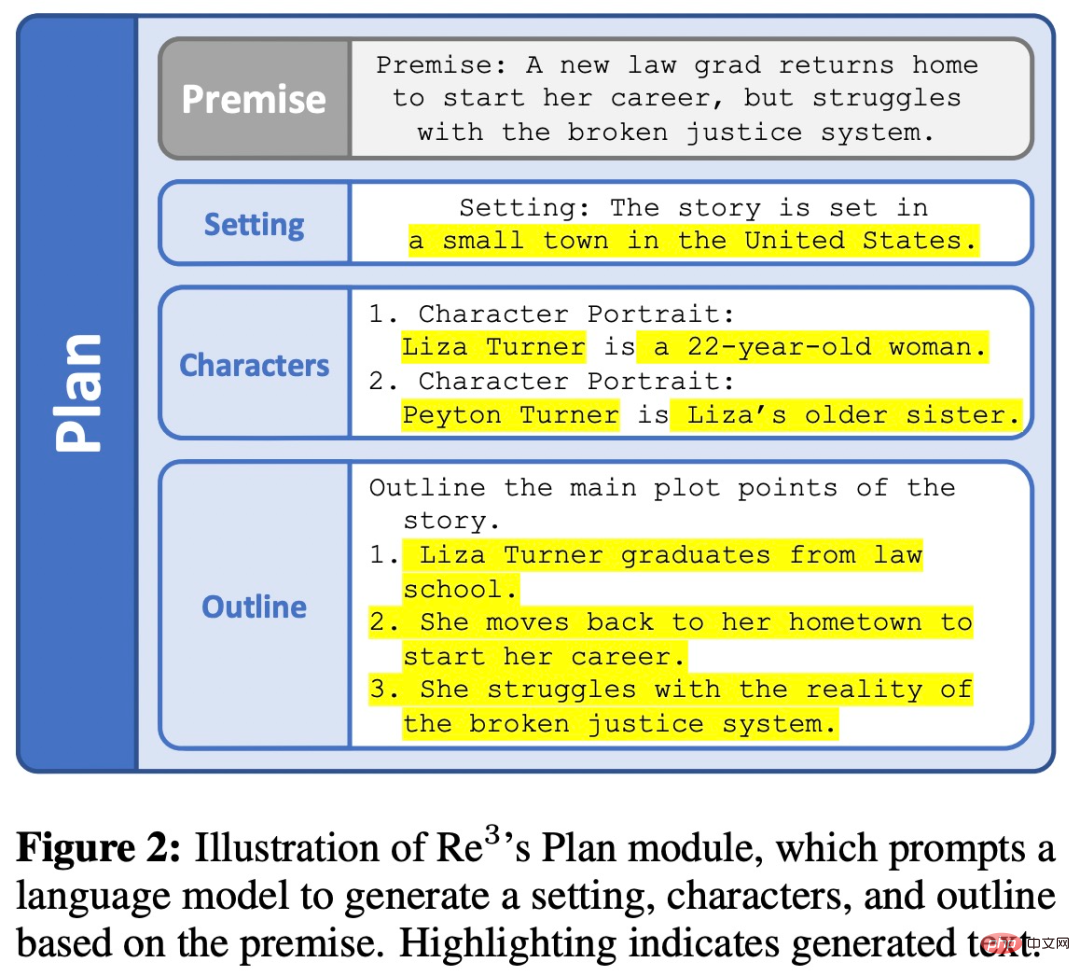
Draft module
For each result obtained by the planning module An outline, the draft module will continue to generate several story paragraphs. Each paragraph is a fixed-length continuation generated from a structured prompt formed by a recursive reprompt. The draft module is shown in Figure 3 below.
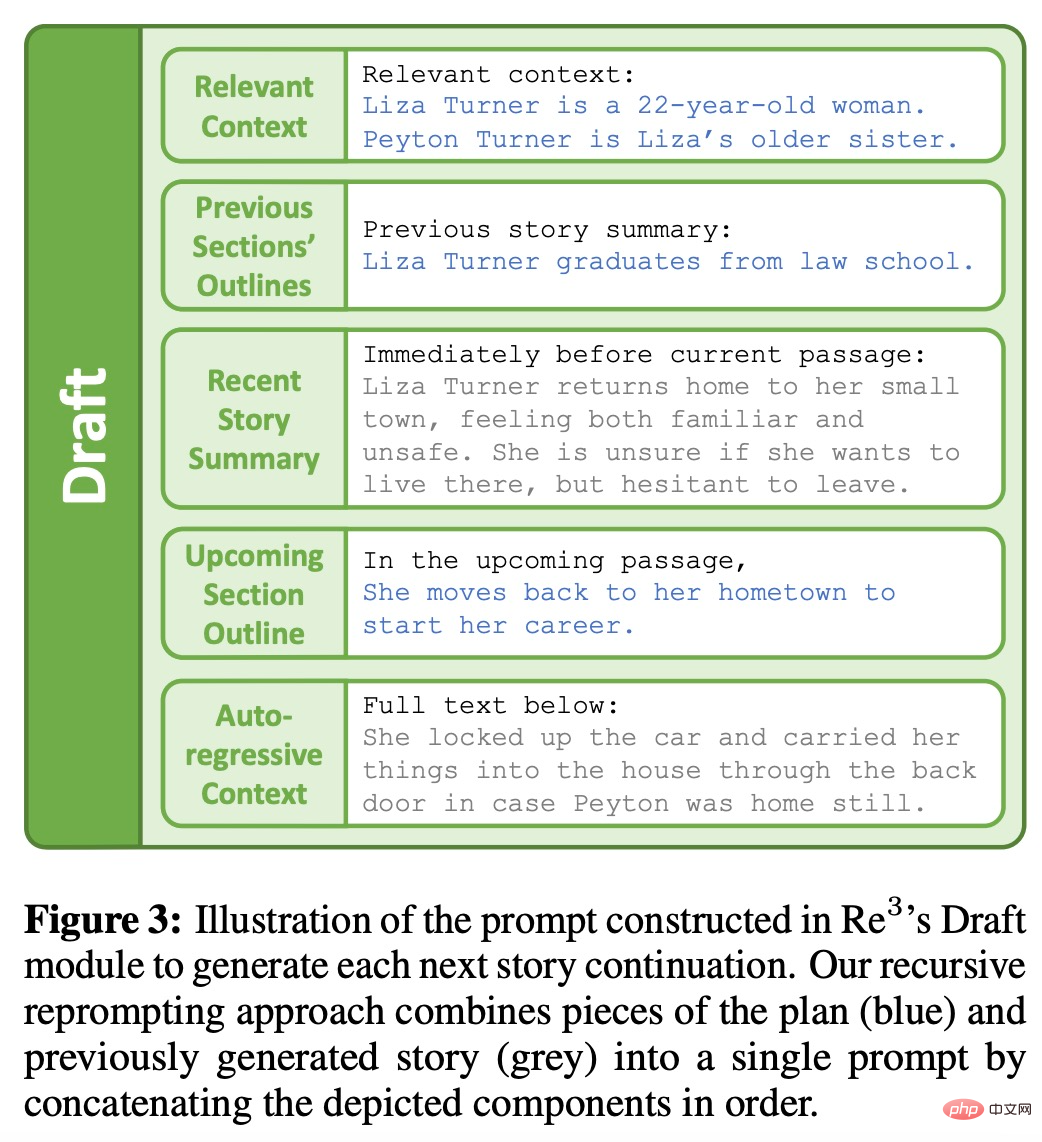
Rewrite module
The first one of the generator The output is often low quality, like a first draft that people complete, a second draft that may require rewriting an article based on feedback.
The Rewrite module simulates the rewriting process by reordering the Draft module output based on coherence with previous paragraphs and relevance to the current outline point, as shown in Figure 4 below.
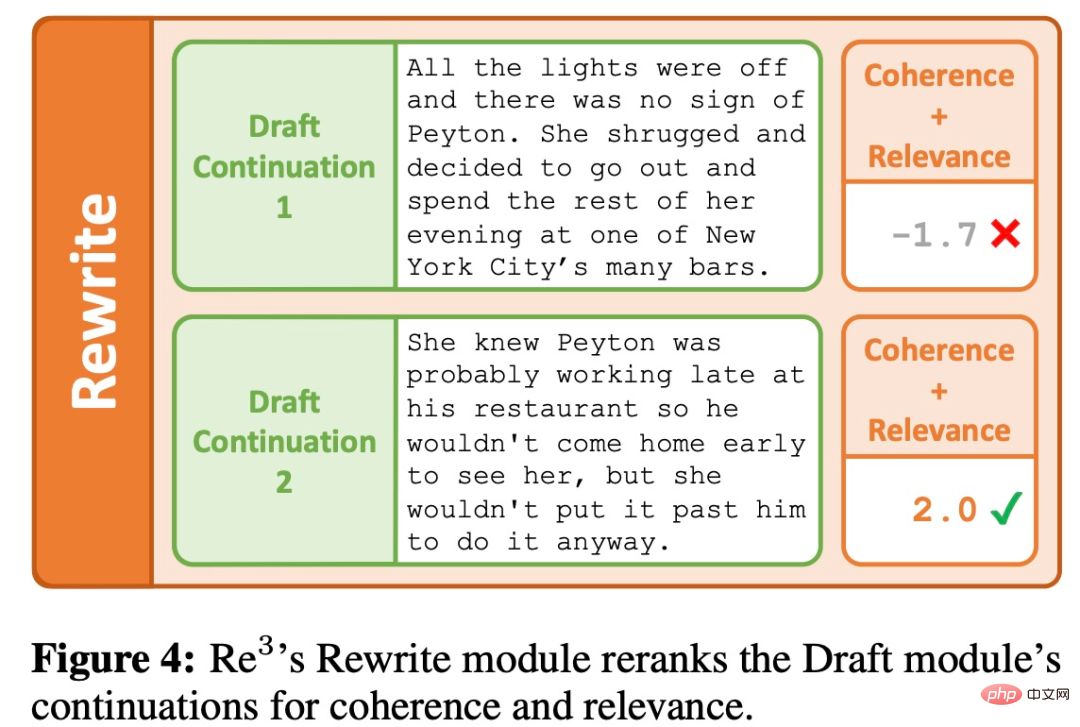
Edit module
#Different from substantial rewriting, the editing module is generated through the planning, drafting and rewriting modules. Partial editing of paragraphs to further improve the generated content. Specifically, the goal is to eliminate long sequences of factual inconsistencies. When one discovers a small factual discontinuity while proofreading, one may simply edit the problematic detail rather than make major revisions or substantive rewrites of the high-level article plan. The editing module mimics this process of human authoring in two steps: detecting factual inconsistencies and correcting them, as shown in Figure 5 below.
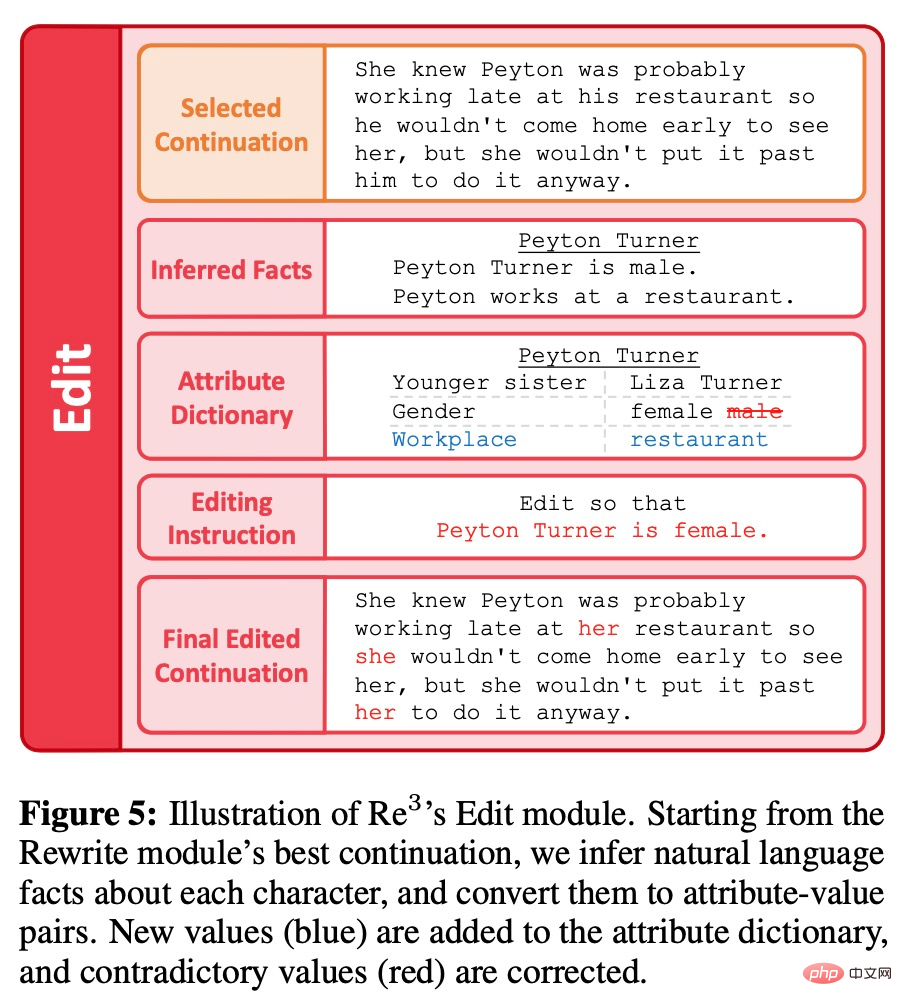
Evaluation
In the evaluation session, the researcher sets the task to perform a brief initial A story is generated from the previous situation. Since “stories” are difficult to define in a rule-based manner, we did not impose any rule-based constraints on acceptable outputs and instead evaluated them through several human-annotated metrics. To generate initial premises, the researchers prompted with GPT3-Instruct-175B to obtain 100 different premises.
Baseline
It was difficult since the previous method focused more on short stories compared to Re^3 Direct comparison. So the researchers used the following two baselines based on GPT3-175B:
1. ROLLING, generate 256 tokens at a time through GPT3-175B, using the previous situation and all previously generated stories The text is used as a prompt, and if there are more than 768 tokens, the prompt is left truncated. Therefore, the "rolling window" maximum context length is 1024, which is the same maximum context length used in RE^3. After generating 3072 tokens, the researchers used the same story ending mechanism as RE^3.
2. ROLLING-FT, the same as ROLLING, except that GPT3-175B first fine-tunes hundreds of paragraphs in the WritingPrompts story, which have at least 3000 tokens.
Indicators
Several evaluation indicators used by researchers include:
1. Interesting. Be interesting to readers.
2. Continuity. The plot is coherent.
3. Relevance. Stay true to the original.
4. Humanoid. Judged to be written by humans.
In addition, the researchers also tracked how many times the generated stories had writing problems in the following aspects:
1. Narrative. A shocking change in narrative or style.
2. Inconsistency. It is factually incorrect or contains very strange details.
3. Confusion. Confusing or difficult to understand.
4. Repeatability. High degree of repeatability.
5. Not smooth. Frequent grammatical errors.
The results

## are shown in Table 1 As shown, Re^3 is very effective at writing a longer story based on anticipated events while maintaining a coherent overall plot, validating the researchers' design choices inspired by the human writing process, as well as the reprompting generation method. . Compared with ROLLING and ROLLING-FT, Re^3 significantly improves both coherence and relevance. The annotator also marked Re^3's story as having "significantly fewer redundant writing issues".
Re^3 shows strong performance in an absolute sense: annotators believe that in the two comparisons, 83.3% and 80.0% of Re^3's stories were written by humans, respectively. Table 2 shows a heavily abridged story example from Re^3, showing strong coherence and context relevance:
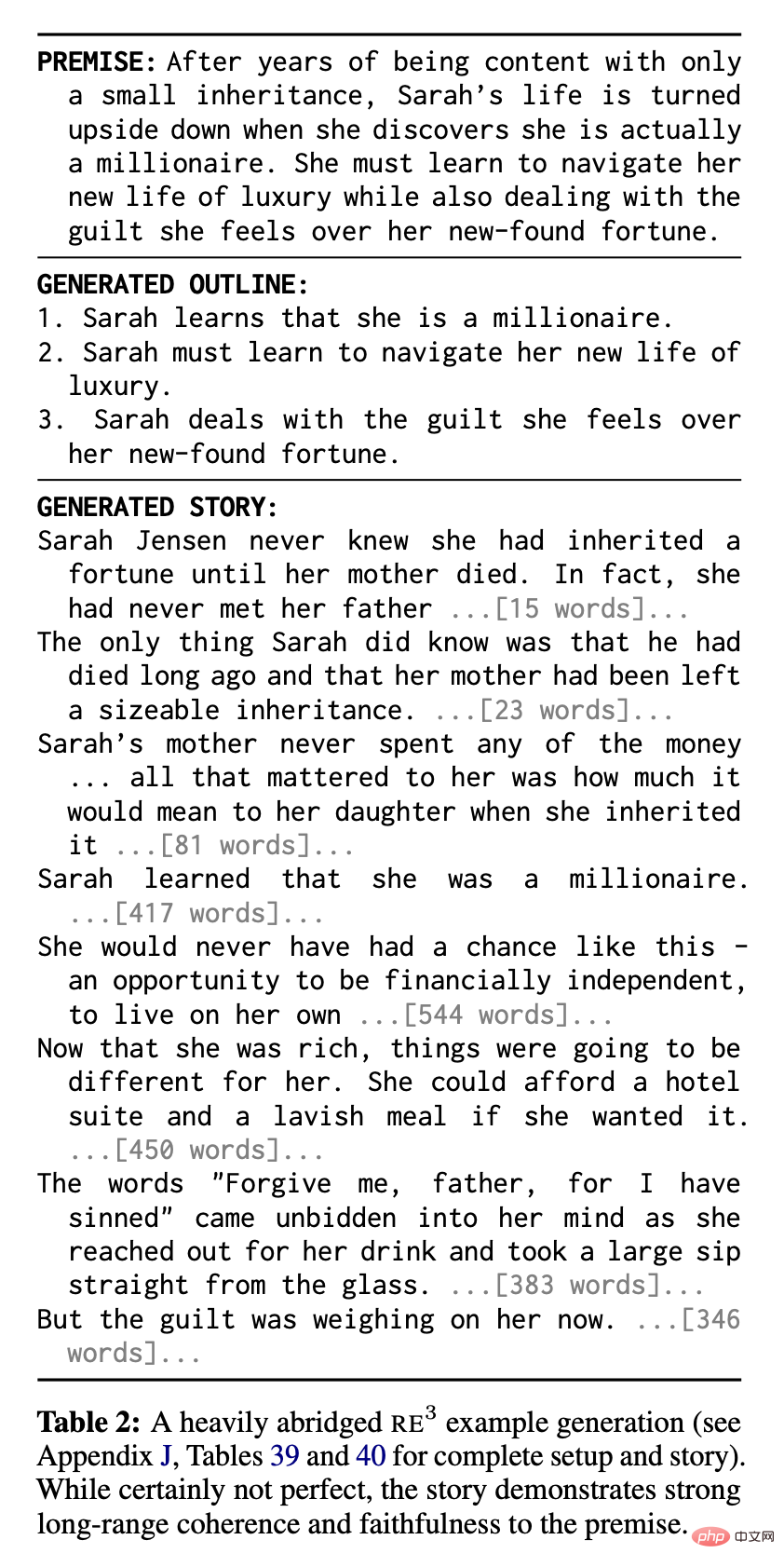
Despite this, researchers still qualitatively observed that Re^3 still has a lot of room for improvement.
Two common issues are shown in Table 3. First, although Re^3s almost always follow the story premise to some extent, unlike baseline stories, they may not capture all parts of the premise and may not follow the partial outline generated by the planning module (e.g., Table 3 The first part of the story and outline). Secondly, due to the failure of the rewriting module, especially the editing module, there are still some confusing passages or contradictory statements: for example, in Table 3, the character Jaxon has a contradictory identity in some places.
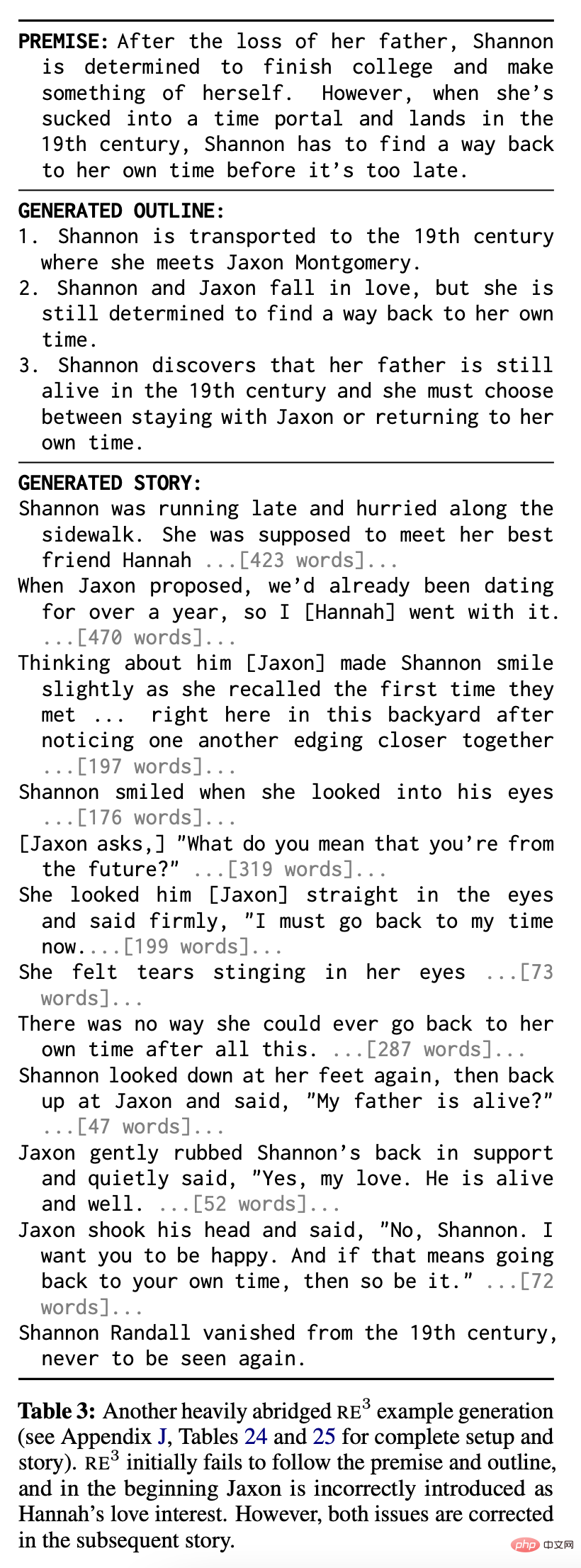
However, unlike the rolling window method (rolling window), Re^3's planning method can "self-correct" , back to the original plot. The second half of the story in Table 3 illustrates this ability.
Analysis
Ablation Experiment
The researchers discussed the various modules of Re^3 Relative contribution of: planning, drafting, rewriting, and editing, and conducting ablation experiments on each module in turn. The exception is the Draft module, as it is unclear how the system would function without it.
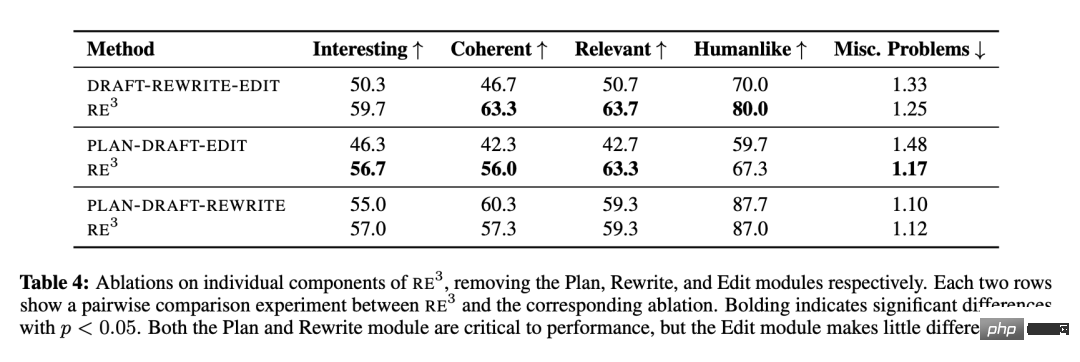
Table 4 shows that the “Planning” and “Rewriting” modules that imitate the human planning and rewriting process have an impact on the overall plot. Coherence and the relevance of premises are crucial. However, the "Edit" module contributes very little to these metrics. The researchers also qualitatively observed that there are still many coherence issues in Re^3's final story that are not addressed by the editing module, but that these issues could be resolved by a careful human editor.
Further analysis of the "Edit" module
##The researcher used a controlled environment to study Whether the Edit module can at least detect role-based factual inconsistencies. The detection subsystem is called STRUCTURED-DETECT to avoid confusion with the entire editing module.
As shown in Table 5, STRUCTUREDDETECT outperforms both baselines when detecting role-based inconsistencies according to the standard ROC-AUC classification metric. The ENTAILMENT system's ROC-AUC score is barely better than chance performance (0.5), highlighting the core challenge that detection systems must be overwhelmingly accurate. Additionally, STRUCTURED-DETECT is designed to scale to longer paragraphs. The researchers hypothesized that the performance gap would widen in evaluations with longer inputs compared to the baseline.
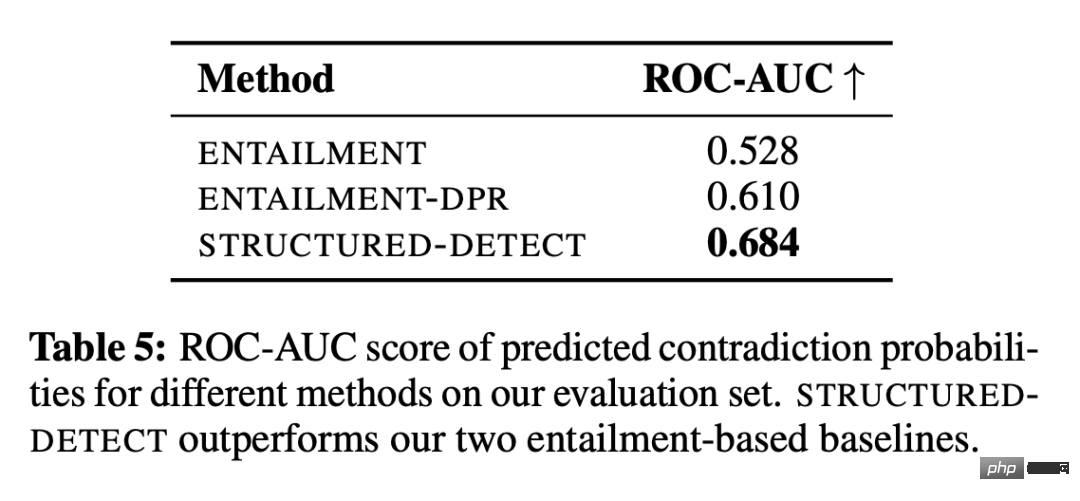
Even in this simplified environment, the absolute performance of all systems is still low. Additionally, many of the generated complete stories contain non-character inconsistencies, such as background inconsistencies with the current scene. Although the researchers did not formally analyze the GPT-3 editing API's ability to correct inconsistencies after detecting them, they also observed that it can correct isolated details but struggles when dealing with larger changes.
Taken together, compound errors from the detection and correction subsystems make it difficult for this study’s current editing module to effectively improve factual consistency across thousands of words, without introducing unnecessary changes at the same time.
The above is the detailed content of AIGC that conforms to the human creative process: a model that automatically generates growth stories emerges. For more information, please follow other related articles on the PHP Chinese website!

Hot AI Tools

Undresser.AI Undress
AI-powered app for creating realistic nude photos

AI Clothes Remover
Online AI tool for removing clothes from photos.

Undress AI Tool
Undress images for free

Clothoff.io
AI clothes remover

AI Hentai Generator
Generate AI Hentai for free.

Hot Article

Hot Tools

Notepad++7.3.1
Easy-to-use and free code editor

SublimeText3 Chinese version
Chinese version, very easy to use

Zend Studio 13.0.1
Powerful PHP integrated development environment

Dreamweaver CS6
Visual web development tools

SublimeText3 Mac version
God-level code editing software (SublimeText3)

Hot Topics
 1377
1377
 52
52
 How to add a new column in SQL
Apr 09, 2025 pm 02:09 PM
How to add a new column in SQL
Apr 09, 2025 pm 02:09 PM
Add new columns to an existing table in SQL by using the ALTER TABLE statement. The specific steps include: determining the table name and column information, writing ALTER TABLE statements, and executing statements. For example, add an email column to the Customers table (VARCHAR(50)): ALTER TABLE Customers ADD email VARCHAR(50);
 What is the syntax for adding columns in SQL
Apr 09, 2025 pm 02:51 PM
What is the syntax for adding columns in SQL
Apr 09, 2025 pm 02:51 PM
The syntax for adding columns in SQL is ALTER TABLE table_name ADD column_name data_type [NOT NULL] [DEFAULT default_value]; where table_name is the table name, column_name is the new column name, data_type is the data type, NOT NULL specifies whether null values are allowed, and DEFAULT default_value specifies the default value.
 SQL Clear Table: Performance Optimization Tips
Apr 09, 2025 pm 02:54 PM
SQL Clear Table: Performance Optimization Tips
Apr 09, 2025 pm 02:54 PM
Tips to improve SQL table clearing performance: Use TRUNCATE TABLE instead of DELETE, free up space and reset the identity column. Disable foreign key constraints to prevent cascading deletion. Use transaction encapsulation operations to ensure data consistency. Batch delete big data and limit the number of rows through LIMIT. Rebuild the index after clearing to improve query efficiency.
 How to set default values when adding columns in SQL
Apr 09, 2025 pm 02:45 PM
How to set default values when adding columns in SQL
Apr 09, 2025 pm 02:45 PM
Set the default value for newly added columns, use the ALTER TABLE statement: Specify adding columns and set the default value: ALTER TABLE table_name ADD column_name data_type DEFAULT default_value; use the CONSTRAINT clause to specify the default value: ALTER TABLE table_name ADD COLUMN column_name data_type CONSTRAINT default_constraint DEFAULT default_value;
 Use DELETE statement to clear SQL tables
Apr 09, 2025 pm 03:00 PM
Use DELETE statement to clear SQL tables
Apr 09, 2025 pm 03:00 PM
Yes, the DELETE statement can be used to clear a SQL table, the steps are as follows: Use the DELETE statement: DELETE FROM table_name; Replace table_name with the name of the table to be cleared.
 How to deal with Redis memory fragmentation?
Apr 10, 2025 pm 02:24 PM
How to deal with Redis memory fragmentation?
Apr 10, 2025 pm 02:24 PM
Redis memory fragmentation refers to the existence of small free areas in the allocated memory that cannot be reassigned. Coping strategies include: Restart Redis: completely clear the memory, but interrupt service. Optimize data structures: Use a structure that is more suitable for Redis to reduce the number of memory allocations and releases. Adjust configuration parameters: Use the policy to eliminate the least recently used key-value pairs. Use persistence mechanism: Back up data regularly and restart Redis to clean up fragments. Monitor memory usage: Discover problems in a timely manner and take measures.
 phpmyadmin creates data table
Apr 10, 2025 pm 11:00 PM
phpmyadmin creates data table
Apr 10, 2025 pm 11:00 PM
To create a data table using phpMyAdmin, the following steps are essential: Connect to the database and click the New tab. Name the table and select the storage engine (InnoDB recommended). Add column details by clicking the Add Column button, including column name, data type, whether to allow null values, and other properties. Select one or more columns as primary keys. Click the Save button to create tables and columns.
 Monitor Redis Droplet with Redis Exporter Service
Apr 10, 2025 pm 01:36 PM
Monitor Redis Droplet with Redis Exporter Service
Apr 10, 2025 pm 01:36 PM
Effective monitoring of Redis databases is critical to maintaining optimal performance, identifying potential bottlenecks, and ensuring overall system reliability. Redis Exporter Service is a powerful utility designed to monitor Redis databases using Prometheus. This tutorial will guide you through the complete setup and configuration of Redis Exporter Service, ensuring you seamlessly build monitoring solutions. By studying this tutorial, you will achieve fully operational monitoring settings



